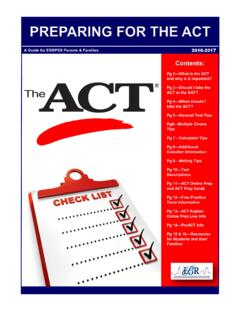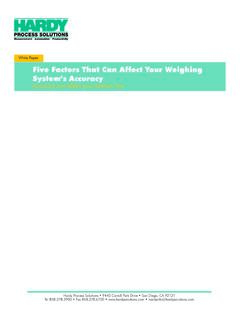Transcription of Gain vs. Proportional Band - h240.marcks.cc
1 gain vs. Proportional band The end result of the analysis of a typical loop tuning procedure, whether open loop or closed loop, is a set of parameters with which to adjust the controller. One of these parameters is controller gain . But what if your controller has its gain slider labeled and calibrated as percent Proportional band ? Not a problem. Just take the reciprocal of gain and multiply by 100, right? Not necessarily. The following relationship between gain and percent Proportional band is well known. 100%PBGain= However, what is not well known is the fact this relationship is based upon the assumption the input and output ranges of the controller are equal. In other words, assume you have an electronic controller with an input range of 4-20 ma and an output range of 4-20 ma. Further assume the controller is driving an electronic actuator with a full stroke that occurs with an input signal (to the actuator) of 4-20 ma. In such a case, the above relationship holds true. But what about the following cases: An electronic controller driving an electronic actuator where the signal necessary to do so is only a percentage of the output range of the controller.
2 An electronic controller driving a pneumatic actuator through an I/EP valve A pneumatic control system In these cases, the gain and percent Proportional band are not necessarily reciprocals as generally stated in the typical textbook. We will address these situations by example later. For now, let's determine how to convert from gain to percent Proportional band in the general case. To do so, we need to review the definitions of gain , Proportional band , and percent Proportional band . gain : The ratio of the change in output signal to the change in input signal defines controller gain . As an example, suppose you have a controller that accepts a 4-20 ma current signal and provides a 4-20 ma output signal. Further assume you apply a step change of 2 ma to the input terminals of the controller and you measure a change of 5 ma at the output terminals. The controller gain is then: Proportional band : The amount of change in the controlled variable, expressed in engineering units, required to move the actuator from one end of its stroke to the other.
3 This is also referred to as throttling range. %PB: Percent Proportional band is the Proportional band expressed as a percentage of the sensor span. It is sometimes called percent throttling range (%TR). For example, if you had a room temperature process with a throttling range of 5 oF and a sensor with a range of 60 to 85 oF, then the percent Proportional band would be: ()5100%%20%85 60ooFPBF == Using these basic definitions, let's consider three separate controllers. Each controller accepts a 4-20 ma input signal. However, one has an output capability of 4-20 ma, another outputs 4-16 ma, while a third outputs 4-12 ma. Output12 ma 16 ma20 ma4 ma 4 ma4 maInput Sensor 4 ma Controller20 ma Controller AController BController C Assume each controller has a percent Proportional band slide and this slide is set to 100% on each controller. By definition, a 100% Proportional band means the throttling range equals the sensor span. Since the entire sensor span is also the throttling range, it follows that as the input signal is stepped by 100%, the controller output will also change 100%.
4 Note that in each case, even though the %PB is the same in each case, the change in output is quite different. This is because each has a different output range. Figure 1 The gain for each controller is also quite different. The observed gain for each controller is as follows: Controller A: ()()20 4cmaKma == Controller B: ()()16 4cmaKma == Controller C: ()()12 4cmaKma == Obviously, only the first value of gain is the reciprocal of the controller s percent Proportional band setting while the other two are not. In order to determine the proper Proportional band setting from the value of gain for controllers B and C, we must normalize the controller output to the controller input as follows: 100%%cActuatorSpanPBKI nputSpan= So we can now calculate the %PB for each of the above three controllers as follows: Controller A: ()()20 4100%%100%1204maPBma = = Controller B: ()()16 4100%%100%1204maPBma = = Controller C: ()()12 4100%%100%1204maPBma = = For illustration, the above examples assumed the actual output of the controller was limited to something less than 4 - 20 ma.
5 Of course, the typical electronic controller always has an output range equal to its input range, both of which are standardized to some standardized process signal ( : 4-20 ma, 0-5 volt, 0-50 mV, etc.) However, when Open100010 1200 14 110012 ma16 ma70 150 F Controller TR=200 SP=1100 T Output Signal maClosedInput SignalFigure 2 Control loop and control diagram for example problem an end-device requires an input current (or voltage) range less than the output capability of the controller, the result is the same as described above. For example, shown below is a single loop electronic controller receiving a signal from a 70 to 150 oF temperature sensor. The sensor outputs 4 - 20 ma over its sensing range. Although the controller is capable of an output of 4 - 20 ma, the actuator strokes the normally closed heating valve full closed to full open with a 6 - 16 ma input signal. Using the fundamental definition of gain , we can define controller gain by expressing the entire Proportional band (controller input) in terms of current and the controller output as 6 to 16 ma.
6 Then: ()()16 614 10maGainma = Realizing the input and output ranges are not equal, we can calculate the %PB as follows: ()()16 6100%%25% 4maPBma = = The above example assumed an electronic actuator with an input range less than that of the controller output range. What is more common is the use of an I/P or E/P valve driving a pneumatic actuator. In most cases, the I/P or E/P transducer will output a 3 - 15 psi signal with a 1 - 5 v, a 2 - 10 v, or a 4 - 20 ma signal. However, the I/P (E/P) generally drives an actuator with a spring range less than the maximum output range of the I/P (E/P). In such a case, the effective output of the controller is reduced. This results in an analysis virtually identical to the above analysis. Take, for example, the above system, but replace the electronic valve actuator with an I/P and a 3 - 9 psi pneumatic valve actuator. A typical I/P will output a 3 - 15 psi pressure with a 4 - 20 ma input current. The 3 - 9 psi actuator has a 6 psi span and represents 50% of the output capability of the I/P.
7 It is easily shown that the corresponding controller output is 4 - 12 ma. This is identical to Controller 'C' in the above example. In other words, the ratio of the effective controller output to the controller input is . Thus, the 3-9 psi 21 IP 70 150 F Controller TR=200 SP=1100 T Figure 3 Example control loop with I/P and pneumatic valve reciprocal of gain must be multiplied by this ratio to obtain a proper %PB setting. Pneumatic Controllers Pneumatic controllers are handled in a similar fashion, but there is one major difference between pneumatics and electronics. The pneumatic controller is powered with a compressed air source with a line pressure usually somewhere between 18 and 25 psi. This compressed air source is also the source of power for pneumatic transmitters (similar to electronic loop powered transmitters). It is also the source of power for actuators if the actuator is equipped with a pilot positioner. In the end, the output capability of any pneumatic controller will be 0 psi to line pressure.
8 Since line pressure is somewhat variable, the output range of any given controller will also be variable. However, even if line pressure was standardized such that the output range of the pneumatic controller was constant, pneumatic actuators are available with varying spring ranges. Thus the effective output of any controller is dependent upon the selection of the actuator. The adjustment of most pneumatic controllers is via a slider or a rotary knob calibrated in percent Proportional band . Remember that Proportional band is defined as: "The amount of change in the controlled " This is a temperature, pressure, or humidity range, in engineering units, over which we wish to control. But this may be expressed as a pressure change in sensor output rather than engineering units. In other words, a change in [controller] input pressure. "..required to run the actuator over its full stroke." In other words, over the actuator spring range expressed in units of pressure. This means a change in [controller] output pressure.
9 This means the output range of all pneumatic controllers would have to be standardized so the manufacturer can provide a calibrated Proportional band scale indexed to this standard output. Herein lies the problem; manufacturers never agreed upon a single standard controller output. Every manufacturer calibrates their controller based upon their idea of what this should be. Table 1 lists standard outputs adopted by some manufacturers for some of their controller models. However, if we know what this standard output range is, we can use it to rewrite the equation for percent Proportional band by indexing the sensor to both the controller output range and the actuator range as follows: .%100%ProportionalBandStd Controller OutputPBSensorSpanActuatorSpringRange= MANUFACTURER STANDARD OUTPUT Powers 5 psi Honeywell 10 psi Barber Colman 10 psi Robertshaw 12 psi Kreuter 12 psi Table 1 Standard Controller Outputs If we use the previous example, we note the sensor has a range of 70 oF - 150 oF (80 oF span).
10 The throttling range is 20 oF and the actuator has a 6 psi spring span. We can determine the value of controller gain as follows. ()()15 == () ()oopsiProportionalBandin psiFpsiControllerinputF= = 936 ControllerOutputSpring Rangepsi== = 623psiControllerGainpsi== This value of gain is correct regardless of the controller being used. However, we must now convert this to a Proportional band setting for our particular controller. Using the above equation for %PB, as developed for pneumatic controllers, we can determine the correct value of %PB to which we must set each controller in order to obtain the desired value of gain . Using the standard outputs listed in Table 1. 205% ==(Powers) (Honeywell) (Barber Colman) 2010% == (Krueter) (Robertshaw) 2012% == Note the reciprocal of the percent Proportional band matches the gain calculation only in the last case when the standard controller output is equal to the input span.









